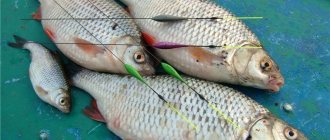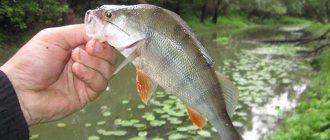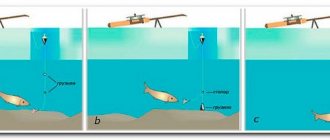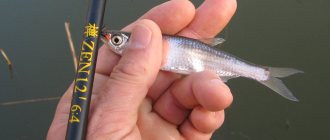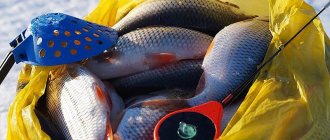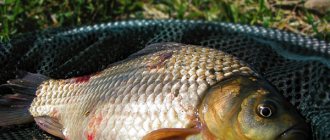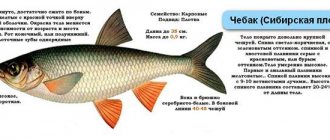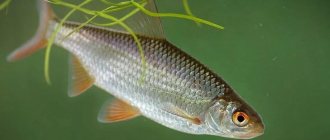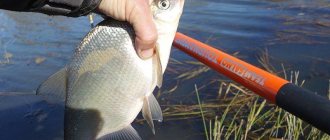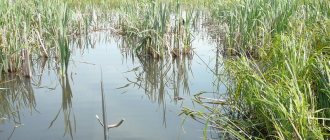- Characteristic feeding habits and habitat of roach
- What do roaches bite on?
- Methods of catching roach
- Bait for catching roach
- Catching roach with a float rod
- Catching roach with a Bolognese rod
- Technique for catching roach using a bolognese float rod
- Catching roach with a fly rod
- Technique for catching roach with a float fly rod
- Catching roach with a match rod
- Technique for catching roach using a float match rod
- Catching roach with a plug rod
- Baits for catching roach on a float rod
- Bait for catching roach on a float rod
- How to spot a bite
- How to hook
- How to catch roaches
- How to choose a fishing spot
- What to cook from roach
- Video: secrets of catching roach in the fall.
Roach, roach, ram, roach and even chebak - all these are different names for the same fish, the common roach, the most common freshwater species on the Eurasian continent.
Catching roach with a float rod is popular among many fishermen. This fishing method is easy to use and shows good results not only when catching roach, but also many other fish. Catching roach with a float rod does not require any special preparation; it is enough to prepare your gear, bait and groundbait and you can go after the roach.
Roach fishing.
This is an extremely unpretentious fish: it lives equally well both in small rivers, almost streams, ponds and lakes, and in large rivers, and some of its species live even in the lightly salted seas - the Azov, Black and Caspian seas. But a large number does not make roach fishing easy. This fish is capricious, its habits change throughout the year, it is selective about bait, and bites carefully. Therefore, fishing for roach requires a lot of effort and knowledge from the fisherman.
Characteristic feeding habits and habitat of roach
The appearance of the roach depends on local habitat conditions and the age of the fish. Most often, the color of the back is black with a blue or greenish tint, the sides of the body and belly are silver-white, the dorsal and caudal fins are greenish-gray with a reddish tint, the pectoral fins are pale yellowish, the ventral and anal fins are red, the iris is yellow with a red spot at the top. The length of roach is usually 15-18 cm and for the most part does not exceed 30 cm. Weight is 50-300 g. However, under favorable conditions, that is, with abundant food and sufficient space in the habitat, roach is not inferior in growth to many other carp fish. In lakes, as well as in the Caspian and Azov seas, it reaches a much larger value, and in some Trans-Ural lakes it has gigantic dimensions - up to 50 cm in length and more than 2.5 kg in weight.
In spring, schooling roaches gather in places well-warmed by the sun.
In early spring, after the waters have opened, the roach stays close to the shore. In rivers, it very often comes out onto the floodplain, into oxbow lakes and flood lakes, where a significant part of it remains even when the water recedes. Like all other fish, the roach also has a tendency to rise up against the current, caused by the turbidity of the water, but at the first opportunity it tries to go out into the flood or into the mouths of tributaries and never goes far from its dens. Having spawned, the roach in the rivers initially stays everywhere except in rapids, but as soon as grass appears, it moves into bays, backwaters and channels, and in the absence of such, into holes with a weak current, to swimming pools, bridges and other surface structures. In the summer heat, the roach either goes deeper or gets buried under the shore and in the roots of coastal bushes.
The main food of roaches in rivers in summer consists of filamentous algae growing on piles, less often stones, in small currents. In addition, of course, various small animal organisms - small shells, fry and crustaceans - serve as food for roaches. With the onset of cold weather, in October or November, roaches, both river and lake, go to winter in deep holes, and again gather, if necessary, in large and very dense schools.
What do roaches bite on?
Roach is a fish belonging to the carp family. Accordingly, its diet is quite varied and depends on the time of year. Thus, in the summer, the diet of roaches is dominated by plant foods, supplemented by various small larvae and aquatic insects. This is the most fertile time, from a nutritional point of view, and the roach takes full advantage of it. It can be caught with equal success using a worm, maggot, bloodworm, mayfly larva, caddis fly, worm and bloodworm. At the same time, the roach responds with pleasure to various types of dough, bread crumbs, steamed cereals, as well as to some types of plants.
Roach is not a fish that digs through silt and other bottom sediments in search of food. Basically, its food is zooplankton, which lives in the water column and on plant stems. Therefore, if there is a choice between bloodworms and mayfly larvae, or maggots, the first will not be so in demand. Although, given the omnivorous nature of roach, bloodworms as bait also give good results.
Summer is the best time to offer plant food to roaches. Many fishermen, with the onset of the warm season, catch it with great success using filamentous algae, which cover the stones at the bottom and the walls of various hydraulic structures, dams, bridge piles, and concrete foundations with a continuous carpet. The peak of such activity occurs at the end of spring - beginning of summer, when roaches feed mainly on this grass rich in microelements. When gutting fish during this period, this is clearly noticeable - only greens are present in the stomach and intestines.
Anglers actively take advantage of this, using so-called “green bait” fishing near dams and bridges. This fishing is very productive and exciting, although it does not last very long. The roach is actively interested in mulberry for a relatively short time, and over the next few weeks it completely switches to other available food.
The roach's bite is extremely capricious: today it takes well, tomorrow it doesn't take at all for no apparent reason. This fish is very lethargic, and if it is full, it is reluctant to rise or fall behind the falling bait. One of the most successful ways of fishing for roach is on greens. It begins as soon as warm weather sets in and 4 cm of greenery appears on the stilts, and continues until September.
It has been noticed that with each not only strengthening, but also weakening of the current, the roach begins to take on the greens more greedily. The method of planting greenery is quite original. Take a strand no shorter than 9-13 cm, with a thickness of 2 to 5 mm, bend it in half and make a double loop in the middle in the shape of the letter P. Thread a hook into the hole in the loop, tighten the loop and cut the ends so that the length of the strand is at least 4 cm This lightest bait swims ahead and is swallowed before the fish feels the hook.
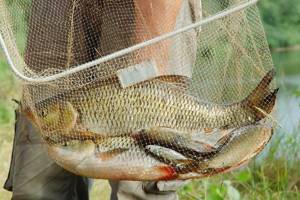
Anise, which is used as a flavoring, has a positive effect on the appetite of roaches.
If with animal baits everything is relatively simple - the size of the bait should correspond to the size of the fish, then with the use of various cereals, there are small nuances. Thus, the proposed bait should be softened, but elastic enough to stay on the hook.
To do this, pearl barley, oats or other cereals are pre-steamed. A thermos with a wide neck is best suited for these purposes. The cereal is pre-washed, poured into a thermos, poured boiling water, sealed and left overnight. By morning, the bait will swell and be ready for use. Cooking cereal is quite a troublesome task, since there is a high probability that the porridge will burn or not be cooked enough. In this case, it is best to use the so-called “water bath”, when the saucepan with the bait being prepared is placed in another, larger one, into which water is first poured. Roaches have a very negative attitude towards foreign odors, in particular the smell of burnt food. A water bath avoids this.

Choosing a place to catch roach is not difficult. The search for roach should begin at shallow depths, from 1 to 4 meters.
In addition to standard cereals, in summer another interesting attachment is used. This is thin pasta cooked until al dente. The pasta is cut into small pieces and placed on a hook with a stocking. This is a very affordable, effective and easy-to-use bait, which only requires proper storage to prevent it from souring and becoming too soft.
Closer to autumn, the roach switches to animal food and the best bait will be maggots, a piece of earthworm and various larvae. By the time of freeze-up, roaches are caught only with bloodworms and burdock larva, which is explained by a decrease in the daily food “doses” of wintering fish and the easy availability of these baits in winter. True, in some reservoirs, especially those that are often visited by fishermen, you can also catch roach using dough, which, for convenience, is pumped into a disposable medical syringe.
The unstable bite and general lethargy of roach, as well as any other fish, continues until spring, until the first warm days. During the last period of ice, and in the subsequent period of early spring, metabolic processes in the fish’s body accelerate and it is already quite possible to switch to heavier baits. The favorite among spring baits is, of course, the earthworm, or rather its small pieces that can be attached to a jig or used for float fishing. Then the food cycle repeats again.
In winter, roach is caught at great depths with float rods with a nod to a jig, using bloodworms and dough baits as bait. Before spawning, roach is caught using a worm and bloodworms. With the onset of post-spawning food and for about two weeks - on worms, bloodworms, caddis flies and maggots. In the summer you can also try steamed wheat grains, dough and barley. The best time to catch roach is in the morning and evening hours, and it can be caught with plant baits in the middle of the day.
Lure
Attractive bait is something without which effective roach fishing in the summer with a light float rod is generally impossible and this must be taken into account. A fish with changeable moods, which does not stand in one place for a long time unless there is a compelling reason for this. This is the reason that holds and attracts roaches to the fishing point and should be bait.
After choosing a fishing point, a starting feed is made in the form of 5–10 balls of bait, the size of a fist (or 50 cm in diameter). This step will definitely attract the fish to the point and hold it until all the bait is gone. Small fish quickly take away food particles and the fisherman must feed the swim in a timely manner to retain the fish and attract trophies.
Most often, the first to come to the bait is a small roach, which takes the bait greedily, but is not of great interest to the fisherman. However, a “merry feast” of small fish certainly attracts the attention of worthy trophies, and if the angler has enough patience and regularly feeds the point, there is a chance to catch them.
Summer bait for roach should contain “dusting components”, due to which a kind of trail will appear in the water column, attractive to fish. But the dusty fraction alone is not enough, because heavy bait must remain at the bottom, which the trophy roach will bite on. The easiest way is to use pellets for these purposes, but there are also folk recipes for baiting roaches in the summer that are no less catchy and more economical.
To prepare homemade bait for summer roach, use:
- wheat flour and millet;
- oatmeal and ground corn sticks;
- semolina and milk powder
- ground boiled peas and barley;
- cornmeal and breadcrumbs.
This list can be continued for a very long time, and it shows that almost any grain mixture and flour, confectionery waste and ground cookies and cereals that are found in every home are suitable for homemade bait.
To enhance the attractiveness of bait, fishermen use food additives:
- vanillin;
- dry dill;
- molasses;
- sunflower cake;
- ground hemp seeds.
In the summer, fish especially love sweet ingredients and ground corn sticks or cookies, which will significantly increase the effectiveness of the bait mixture.
To make the bait heavier and place the fish at the point when fishing in a retrieve, use soil from the reservoir.
The bait is moistened and mixed with clay or soil and formed into balls. The wet and heavy mixture will be slowly washed away by the current, and small particles will retain small roach and attract trophy specimens. The frequency of tossing the balls depends on the biting activity and you should not overfeed the fish if the bites are frequent.
When catching roach from a boat, anglers use the old-fashioned method of feeding a point, when sunflower cake in bars is poured into the net and thrown 5–10 meters upstream. The fluff gets wet, its particles are washed out and move with the current, attracting fish. This bait is inexpensive and “works” for 4–6 hours, depending on the amount of cake and its density.
Makuha attracts roaches with its scent from a long distance and, in addition, has nutritional value for fish, that is, it is one of the best types of bait. When fishing with topwater in still water, take a fine mesh or stocking and use ground cake.
Methods of catching roach
The main method of fishing for roach is fishing with a long rod with a float, practiced in both still and slow-moving waters. The difference lies in the attachments. When using baits, roach fishing can last almost the whole year. In addition, roach can be caught at night - in the river with bottom fish, and in ponds with float rods, using lighting, which, at the same time, serves as fish bait. Roach is almost the only fish that is more convenient and profitable to catch from the shore than from a boat. The easiest way to catch roach is by wire, with a fishing line up to 14-18 m long and a light float.
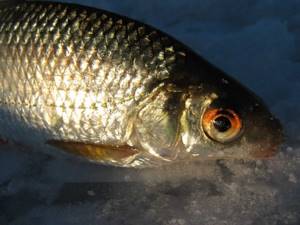
Alternate baits, if the roach has become difficult to take on maggots, replace it with a worm or use it together as part of the so-called “sandwich”.
In general, the best depth for fishing for roach is 1.5-2 m; place - on the border of the grass, in clearings between the grass, in creeks and in weak currents. The most intense roach bite is in the summer, before heavy rain with thunder and lightning, when the roach greedily grabs almost any bait for about an hour. During the autumn heat, before the onset of frost, the roach takes bait throughout the day. Roach bites are very varied: sometimes it dips the float, sometimes even puts it on the water.
Bait for catching roach
Bait is more necessary in stagnant or semi-stagnant water - in ponds and lakes. In rivers, you can limit yourself to throwing bait while fishing. The fish standing downstream, encountering particles of food floating past, rises higher, to the very source, and here meets the fisherman’s hook with an even more delicious bait.
The best bait is bloodworms: in May, after the roach spawns, and then in August or early September. At the end of May and June, you can successfully catch roaches by feeding them with ant eggs. Both are usually crushed together with the clay. For bait, it is better to use not pure bloodworms, but together with algae and debris. The weaker the current, the looser and smaller the clay balls with bait should be.
Roach spawning
The roach becomes sexually mature when it is three years old. Immediately before spawning, the body of males is covered with small bumps, and the fish itself becomes a little rough to the touch. Spawning begins after the water warms up to 8-10 degrees. In most regions of our country this happens in April-May. Roach spawns for about six days in good, established weather, but if it changes for the worse, spawning can last up to two weeks.
The fish come out to flooded meadows to spawn, laying their eggs on last year’s grass and bushes. You can guess that the roach has begun spawning by the noisy splashes made by the fish during mating games.
Video of underwater filming of roach spawning
Catching roach with a float rod
Roach begins to spawn at water temperatures above 10-13 degrees. During spawning, fish can only be caught from the shore and only with float or bottom gear, although we note that during this period, the roach is not particularly concerned about food and the bite worsens.
Catching roach with a float rod is popular among many fishermen. This fishing method is easy to use and shows good results not only when catching roach, but also many other fish. Catching roach with a float rod does not require any special preparation; it is enough to prepare your gear, bait and groundbait and you can go after the roach.

If the roach stops biting, try throwing in an additional portion of bait and lowering the bait even deeper.
The roach bite changes depending on the season, so the equipment of the float rod also changes. For example, in the spring, using a light float, you can catch a dozen bleaks, but you will never see a roach. But summer roach, which does not urgently need food, or similar autumn roach, requires more delicate gear.
Catching roach with a float rod is possible using four different rods - Bolognese, fly, match and plug. For a beginner, it will be easiest to master Bolognese or fly fishing and, as you gain experience, move on to plug fishing. Match fishing is mainly used as a sport form of fishing.
The Bolognese or lapdog, as it is often called by fishermen, is a telescopic fishing rod with rings for fishing line and a place for attaching a reel.
The flywheel differs in that it does not have passage rings and a spool holder. The fishing line is attached through a connector at the tip of such a rod.
A pole rod is a long rod consisting of several legs that are connected to each other. It is used not only by amateurs, but also by athletes. A rod stand and a recoil roller are required.
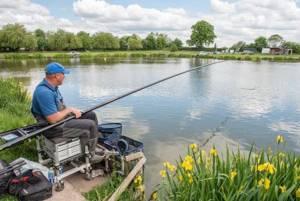
To stimulate roach to bite, raise the float a few centimeters above the water and gently lower it.
A match fishing rod is used for long casts; its structure resembles a spinning rod. It is lightweight, has guide rings for fishing line and a place for attaching a reel. A special device is required for long-distance casting of bait; usually a bait slingshot is used.
The equipment of all fishing rods varies depending on the features of their structure. The main elements are fishing line, float, sinkers and hooks.
How to catch roach in summer
Depending on the type of reservoir, the method of float fishing for summer roach is selected.
It could be:
- fishing in the current;
- static fishing in still water with a floating bait;
- static fishing in weak currents and in a still body of water with a bait at the bottom.
Fishing in the wire
Wiring fishing is carried out from the shore or a boat on a river with a current. In this case, the fisherman throws the equipment upstream and it is carried away by the water flow to the lower critical point.
After the float makes a full pass, the angler checks the condition of the nozzle and rethrows the tackle to the top point. When biting, a sharp hook is made towards the shore or up. The depth of insertion of the nozzle is adjusted by the height of the float on the fishing line and can be quickly changed if necessary.
Wiring fishing is active and the angler holds the rod in his hands, so special requirements are placed on its weight. It’s more difficult to work with a heavy blank, and the angler’s physical load during a whole day of fishing is considerable, so it’s better to take a light fishing rod.
The bait is thrown into the sector so that after each cast the hook with the nozzle passes in close proximity to the baited point.
Static fishing with floating bait
This is the simplest and most comfortable type of fishing for roach in still water using a float. After the fishing spot is abundantly baited, the angler sets the float so that the bait floats in the water column and casts the tackle.
The rod is placed on stands and picked up only after a bite, or if you need to re-cast the tackle. The weight and float balance each other and the bait is in a neutral state.
This method is good because when biting activity decreases, the fishing depth quickly changes and the search for fish becomes easier. Throughout the day, schools of roach change their location, for example, when the pressure decreases, they drop closer to the bottom, and when the pressure increases, they move across all horizons. Taking this into account, exploratory fishing brings real results, and is therefore considered the most effective.
You need to catch roach in summer with floating bait in places where there is no bottom debris, snags or other obstacles. Otherwise, during passage, the hook will cling to obstacles and create problems for the angler.
Static fishing with bait on the bottom
This method of catching roach with a float is considered a hybrid and is very similar to fishing with a donka.
In strong currents, keeping the bait on the bottom is difficult, if not impossible, so static fishing is used for:
- lakes;
- rates;
- paid reservoirs without current;
- reservoirs;
- small rivers with weak currents.
The principle of static fishing with a bait on the bottom is that, having determined the depth at the fishing point, the fisherman raises the float 20–30 cm higher and throws the tackle to the point. The sinker is selected a little heavier than the float test and it turns out that the nozzle remains on the bottom in one place, and when a roach bites, the float immediately signals this to the angler. Hook - and the fish is on the hook!
The advantages of this method are that the bait is always thrown into the same place, and does not float above the bait. While eating food at a point, the fish finds the bait and gets hooked. The float antenna is located on the surface of the water and reacts sensitively to any touch to the nozzle.
When fishing with this method, the catch contains more large fish, but you need to be able to attract them to the fishing point.
The choice of method for catching roach with a float in the summer depends on the type of reservoir and the conditions in which fishing takes place, including weather.
Catching roach with a Bolognese rod
Rod. Catching roach with a float rod using a Bolognese rod is perfect for a beginner. To make your hand less tired, you need to choose a lightweight carbon fiber rod. The choice of length depends on the distance at which you are going to fish. For fishing from the shore, it will be enough to use a rod 5-7 meters long. In addition, the rod has an action and test. The test allows you to find out what weight of equipment you can use when casting without fear of damaging the rod. To catch roach, 3-15 grams or 4-20 grams of dough will be enough. Action determines the shape of a rod's bend under load. For a Bolognese rod, choose a medium or medium-fast action, this will allow you to better control the fish when playing.
Coil. An inertia-free reel with a well-tuned friction brake that allows you to regulate the load. The choice of reel depends on the diameter of the fishing line used. A universal option for a Bolognese rod when fishing for roach would be a reel size 1500-2000 according to the Shimano classification. The reel also has such a characteristic as the gear ratio, which means the number of revolutions that the spool with fishing line makes per revolution of the reel handle. A reel with a ratio of 5.7:1 will do. A similar reel is also suitable for a match rod.
Line and leash . For catching roach, monofilament fishing line with a diameter of 0.12-0.18 millimeters is used. The choice of thickness depends on the fishing location, fishing season and weather conditions. In thickets, a fishing line with a thicker diameter is used, and in a clean reservoir, where there are no snags, for example, a thinner fishing line is used. It is advisable to completely fill the reel spool with fishing line. For the leash, we take a thinner fishing line, a diameter of 0.08-0.1, sometimes 0.12 millimeters and a length of 25-30 centimeters will be enough.
Sinker. Sinkers hold the bait at the required depth and are selected based on fishing conditions - depth and current. The weight of the load must correspond to the load of the float. Loading can be carried out both on a pond and at home. The small and lowest sinker is placed at a distance of 5-7 centimeters from the main ones. The pellets used are lead and are made with a small slot where the fishing line is inserted and then compressed with pliers. If you squeeze too hard, you can damage the line.
Hooks. The hook will be used in sizes No. 3,4,5,6. These hooks bend easily, so you should always have spare hooks with you. For large baits, choose a larger hook.
Float. The choice of float depends on the fishing conditions. In calm weather with a light current, a float with a load of 0.4 grams is used, and in strong winds it is recommended to use a float with a load of 1 gram or more. In addition, this weight is also suitable for long casts. Regarding the attachment of the float, it is better to choose not the option with a ring, but the option with a tube that passes through the entire body of the float, this is more reliable.
Float gear for summer roach fishing

The advantages of summer fishing with float gear are beyond doubt, but to catch large roach you need to choose the right rigs and choose a rod, reel, and fishing line.
From June to August, anglers use the following rods to hunt roach:
- Bolognese;
- flight feathers;
- match.
Each case has its own characteristics, but most often the choice depends on the habits and preferences of the fisherman himself.
They fish with a match rod at a long distance, but for roach this condition is not mandatory, since schools of this fish come close to the coastline without fear.
A fly rod allows you to use the simplest rigs and soft baits, but with a solid length of 8–10 meters, it is not very convenient and requires fly fishing skills, which not all fishing enthusiasts have.
Bolognese rods also have their advantages and are most often used for roach fishing in the summer.
Match
So, match float rods are selected if fishing is carried out:
- from the shore at a long distance on a river with a weak current;
- from the shore at a distance, on a standing body of water, reservoir or headquarters;
- from a boat when fishing under reeds and needing to cast more than 15 meters.
A match rod is taken 4-4.5 meters long, this is enough to cast the tackle to the desired point. A reel with a main line with a diameter of 0.2 mm in a neutral shade or the color of the water is placed on the match. Sliding float, leashes made of monofilament 0.12-0.14, hooks for a selected nozzle.
The size of the hook for catching roach in the summer with a match rod should correspond to the bait that the fish will be tempted by. Naturally, when fishing with maggots, you will need a very small hook (number 16-18), but when using dough, the hook size is smaller (number 12-14), but the thickness of the wire is greater, so that the bait does not fly off when casting .
Expert opinion
Vladimir Poltoranin
Fisherman - expert
The advantages of catching roach for the match are that you fish far away, where the timid fish stands and waits for a tasty treat. But this gear also has a serious drawback, which negatively affects the size of the catch. After casting the equipment, the hook with the nozzle slowly lowers in the water column. But if there are a large number of fish at the fishing point, a bite may follow, which is called “flying in,” even before the float takes its working position.
It turns out that the fisherman is confident that the bait on the hook is safe and sound, but in fact it was stolen long ago by a fish. The solution to the problem will be to make the load heavier, but a float will also be needed with a larger load capacity, which means it will be less sensitive.
It must be admitted that match gear is rarely used for catching roach in the summer, because anglers, avoiding long casts, lure the fish closer to the shore, where they are caught with a fly or Bolognese fishing rod.
Fly feathers
A fly rod is preferable for roach in summer on rivers with currents and on lakes. This applies to static fishing and wire fishing. The absence of a reel makes the gear lighter and simplifies its use, and rods up to 10 meters long help you fish the entire coastal zone without fuss and unnecessary movements that frighten the fish.
Swing fishing is practically silent and therefore, even being in close proximity to the shore, the fish is not afraid of loud sounds and splashes, as is the case when fishing for a match.
To install the equipment on the roach, select a main line of 0.14-0.16, and leashes of 0.10-0.12 mm with hooks suitable for the selected nozzle. It is advisable for the fisherman to have a supply of leashes, because when fishing with a fly rod, when hooked, you have to break off the equipment. Tying leashes with hooks directly on a pond is not always convenient, so you need to be fully prepared.
Fishing from a boat with a fly rod is also effective due to the absence of noise and the ability to cast the equipment directly under the reeds, while being at a distance of the length of the rod, which is 4–9 meters.
It is more convenient to control a fly rod from a boat than, say, a match rod; this also applies to casting and landing caught fish. Even trophy roach rarely exceeds a weight of 400–500 grams, so there is no danger of breaking the form when fishing or hooking a heavy fish.
Despite the fact that the roach does not resist very actively, it is better to buy a high-quality fly rod, because it is lighter and stronger than budget models. When fishing with a float or a fly, you have to hold the rod in your hands for several hours and every extra ten grams of its weight, of course, affects the convenience of the fisherman.
Expert opinion
Vladimir Poltoranin
Fisherman - expert
The advantage of fly fishing gear is that with its help the most fragile and delicate bait is delivered to the fishing point. Power casts are not used when catching roach on the fly, and the rod carefully delivers delicate baits such as dough or hominy, which break when they hit the water, to the desired point.
They fish with a swing both in the retrieve and in a static position, and with such a rod it is more convenient to perform sharp hooks, and they are needed when fishing for roach in the summer. It is more difficult to operate from a boat with a blank that is too long, so in such cases fly rods 4–6 meters long are most often used. Light floats are used with a swing, because thanks to the design of the blank and tackle, they quickly take the working position when casting.
When using a fly rod for line fishing in the current, it makes sense to twitch the tip of the blank when the float reaches the lowest point. The playing bait attracts the fish more actively, and it decides to bite. After the bait gets into the water, a large roach accompanies it as it moves through the water column with the current, carefully examining it and fearing a catch. But the active actions of the fisherman provoke the fish, and it cannot resist trying to taste the mouth-watering treat.
When fishing on the fly and the bite subsides, change baits after each recast of the tackle, this helps in attracting fish.
Bolognese
Bolognese fishing rods are considered the most affordable and accessible both in price and in terms of acquiring the ability to use the tackle. Most float anglers began doing what they loved with Bolognese rods, which were more convenient to transport and prepare for fishing.
They fish with lapdogs both from a boat and from the shore, and fish not only the coastal zone, but also medium and even long distances. When collecting fishing gear close to the shore, it is surrounded by 3-5 pellets, thanks to which the bait sinks into the water faster. This is an important point, since easy installation does not show a decent result when catching active fish.
The bait is pulled off the hook by the fry before the tackle takes a workable position, and the angler doesn’t even know about it. Therefore, slowly sinking the hook with bait is unprofitable and you need to use pellets to solve this problem.
When catching roach in summer from the shore using Bolognese tackle, floats of 2–4 grams, which have an elongated shape, are used. The float must be immersed so that after casting, only a part of the antenna 3–5 cm long remains on the surface of the water.
If the weather is windy, then the visible part of the antenna should be larger; during calm weather, it is enough that only the tip of the bright-colored float antenna is visible. Red is considered to be the most noticeable color, although some anglers prefer to look at an orange or even yellow antenna. So there are no strict recommendations here, and each angler chooses what is more convenient and profitable for him.
When catching summer roach with Bolognese tackle from a distance of 15–20 meters, select a sliding float with a carrying capacity of 6 grams or more. This choice is due to the need to make a power cast, otherwise getting to the fishing point will be difficult, if not impossible. It is preferable to use an olive sliding sinker that does not cling to grass and stones when moving.
For long distances, large floats are needed, but delicate bites are not always visible from them. In summer, this is not too critical, since the fish is looking for food and greedily attacks the bait without delay, swallowing it completely. This bite is clearly visible even with a large float. But in the fall, in cold water, when the fish are inactive, long-distance fishing with Bolognese tackle is ineffective, and it is better to use a fly rod.
Conclusions: The fly tackle is considered the most catchy for summer roach and is used by most float anglers. But in the absence of a fly rod, they use both Bolognese and match gear; the main thing is to select the weight of the float and load so as to ensure maximum sensitivity.
Technique for catching roach using a bolognese float rod
Fishing must begin with baiting the selected area on the reservoir. The main technique for fishing with a lapdog is dragging the bait along the bottom or retrieving it in the water column. The bait should slowly swim across the feeding area, attracting roaches. This will increase the number of bites.
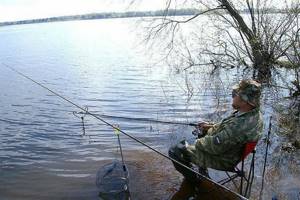
When fishing with a match rod, use a sinker specially designed for this purpose to probe the bottom.
It is recommended to keep the line slightly tight, since the effectiveness of hooking depends on this. Casting must be done smoothly, as the tackle can get tangled. After casting, we wait a little, letting the tackle go with the flow, and then make one or two turns of the handle to reel in the line and bring the float into working condition. Large roach prefer a stationary bait that is located on the bottom.
Roach Habitats | Search for Roaches
On rivers, large roaches love places with steep banks, washed away by the current. Such places are not difficult to identify visually; they are identified by a certain bend in the riverbed.
The search for roach in such places begins with drilling several holes, starting from the very shore, moving away towards the depths.
It has been noticed that roach in such places stay at depths of 4-5 meters, but not deeper. Therefore, when you find such an edge, we recommend that you linger on it and try to catch it better.
As a rule, when you find a roach and a well-fed hole, you come across not only roach, but also good bream and even 1 - 1.5 kg. bream.
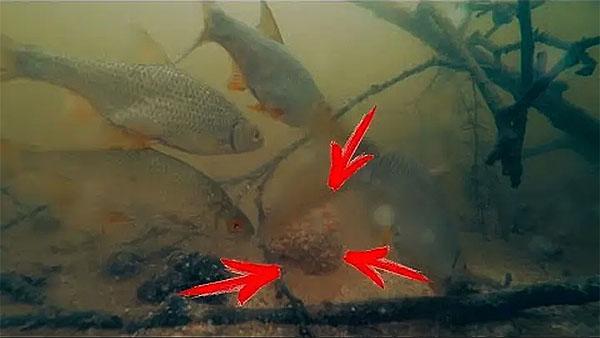
It is worth knowing that in some cases, promising holes do not immediately give any results. Only persistence, along with properly selected bait and periodic feeding of the hole, will give a positive result.
It is imperative to add animal bait to the bait. Bloodworms are often used for this, since it is with this that roaches are caught.
There are quite a lot of variations of different baits and complementary foods, we won’t dwell on that now. Let's talk about this in another article dedicated to roaches.
You can view all the material dedicated to “Roach” in the section: Roach Fishing, or use the site search.
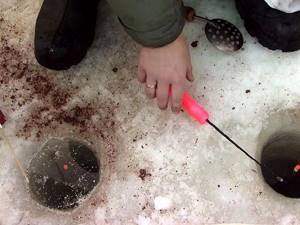
Catching roach with a fly rod
Rod. Catching roach with a float rod using a fly rod is very popular. For it, it is better to choose the lightest possible rod that will allow you to cast without spending a lot of effort. A 6-7 meter long stick is perfect for catching roach.
The equipment of such a rod is attached to the tip through a connector, which is fixed with glue. The connector, like its analogues, can be made yourself or bought in a store.
Line and leash. The choice of fishing line diameter is absolutely similar to the choice of fishing line for a Bolognese fishing rod. A monofilament line is used, with a diameter of no more than 0.18 millimeters, the leash is taken thinner than the main line - from 0.08 to 0.12 mm. The golden rule is that the thinner the leash, the better the roach bite.
Hooks. The rules for choosing a hook are similar to Bolognese fishing. During the current, you can take larger hooks.
Float. For fly fishing, take a float in the shape of a drop or a goose feather, which is mainly used for still water. But for currents, a float in the shape of a reverse drop is perfect. Just like in other types of float fishing, the carrying capacity of the float is selected based on the fishing conditions - depth and current.
Loading. The weight of the weights must be selected according to the carrying capacity of the float. It is better to attach the pellets spaced apart, at different distances from each other.
Catching roach with a match rod
Catching roach with a float rod using a match rod allows you to catch fish at a great distance from the shore, in the bottom layer, including at a depth exceeding the length of the rod. In this way it resembles feeder fishing, only here a feeder is not used. A match rod resembles a long spinning rod with a large number of rings. For catching roach, a match rod 4.2 meters long is suitable.
Coil. It is best to take a spinning reel, with a shallow spool and a gear ratio of at least 1:5. This will help you catch fish at a fast pace.
Line and leash. Here a special match line is used, usually dark in color, which sinks. The cross-section of the fishing line for roach fishing is 0.12-0.16 millimeters. The diameter of the leader is always thinner than the main line. The length of the leash is at least 20 centimeters; usually a long leash is used, up to 60 centimeters.
Hooks. It is selected in the same way as fly or Bolognese fishing.
Float. A special float is used, called a waggler, from 3 to 25 grams. In summer the float is lighter, in cold weather it is heavier. It has its own burden. Some of these floats have the ability to change the load, which is very important when fishing conditions change. For match fishing, a sliding float rig is used, in which the float is limited by a special stopper or a thread knot on the main line only from above. Such a stopper is installed at a distance from the bait corresponding to the fishing depth.
Loading. For match equipment, part of the weight falls on the float itself; additional weights are usually attached to the fishing line above the leash.
Technique for catching roach using a float match rod
Catching roach with a float rod using a match rod always starts with bait. Balls with bait are thrown using a slingshot. You need to start fishing by studying the bottom of the reservoir; for this, a special depth gauge is used.
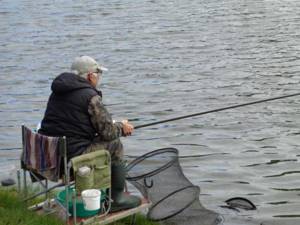
Roach requires constant feeding; in order to keep it in the fishing area, feed the mixture in small portions, otherwise you can overfeed the roach and it will leave.
The tackle is cast at a short distance from the bait site, as a loud splash can scare the roach. Match tackle allows you to make long casts. After casting the float, close the handle on the reel and recess the line with the tip of the rod. Keep the line taut.
Lures and baits
Roaches are caught from the ice both with baitless jigs (such as “devil”, “goat”, “nymph” and others that imitate insect larvae), and with the addition of bloodworms, maggots, worms, and burdock moth larvae. Fans of passive fishing successfully catch roaches using float gear, using animal and vegetable baits (bread, mash, mastyrka, etc.) as bait.
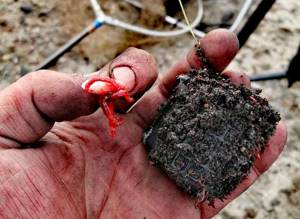
In the spring, roaches prioritize baits of animal origin - maggots, bloodworms, and worms. It takes a little worse on dough, semolina, mastyrka and other vegetable baits.
In summer, the choice of bait is much wider and more varied. Roach bites well on worms, maggots, various larvae, grasshoppers, mussel meat, dough, pearl barley, semolina, bread, etc. Trophy roach can be caught even with boilies.
With the onset of autumn, the gastronomic preferences of roaches are not much different from summer habits. It is still successfully caught both with worms, maggots and bloodworms, as well as with steamed grains, pearl barley, dough, bread, etc.
Catching roach with a plug rod
Rod. The length of the plug rod depends on the fishing location. The choice of length will depend on where the roach is located. The optimal length is considered to be 9-10 meters. Subsequently, this length can be increased.
Line and leash. Monofilament with a diameter of 0.1-0.12 mm is used as the main fishing line. The diameter of the leash is usually 0.08-0.1 mm. It is better to use a rubber shock absorber that is not too thick - about 0.8 mm.
Hooks. The hooks used are small, made of thin wire, approximately No. 18-20.
Float. For fishing with a plug rod, fairly light equipment and floats with a small carrying capacity from 0.5 grams for still water to 6 grams for current are usually used. For fishing with a plug rod in the current, special flat floats are used.
Loading. The load is selected for fishing conditions in the same way as in other types of float fishing. The lightest sinker is usually placed on the leash as a catch, the remaining pellets are distributed higher on the main line at a distance of 10-15 centimeters from each other.
How to catch a large roach
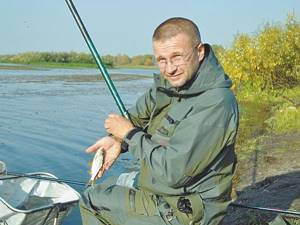
Photo by the author
Roach reacts very well to rye dough. Moreover, very often using rye bread dough is the only effective way to cut small things off the hook and focus exclusively on catching large fish.
Having suffered from an “undivided love” for nimble white larvae, today I cannot imagine catching large lake roach in the fall without rye bread dough. Having become familiar with the basic rules for using this bait, it can be used as easily as the traditional bloodworms, maggots or casters.
I will introduce you to a simple but very effective technique with which you can catch a large roach in any type of body of water with standing water, be it a lake, a reservoir, an oxbow river or a river reach with a slow flow.
Getting the right consistency that would allow the rye bread dough to stick well on the hook is quite simple. To do this, you will need several pieces of “black” rye bread, a saucer, a glass of water and a canvas rag or thick napkin.
Of all the varieties I know, I achieved the best results with Borodino bread. Thick consistency, sweetish taste, and most importantly, a persistent smell of coriander. That's what makes this bread so convenient for making top-notch bait.
Before going fishing, at home I take three slices of bread and cut off the thick crust from them. After that, I put one of the pieces in a saucer and fill it with water. Then the bread soaked in water is placed between the unsoaked pieces, and the entire “sandwich” is wrapped in a canvas rag and kneaded intensively with your hands.
The resulting mass is usually enough for both bait and groundbait. As you can see, everything is as simple as shelling pears. If you don’t want to bother with preparing the dough at home, you can do it while fishing. Instead of a saucer, a plastic bag is quite suitable, and water can be taken directly from the reservoir.
The same “Borodinsky” bread is used as bait. In a pond, several dozen portioned pieces are plucked from the finished dough, which are then rolled out between the palms to form pellets. Then these pellets are thrown to the float during the fishing process.
As noted above, rye bread dough is a bait for use in bodies of water with standing water or weak currents. To compile a photo series for this article, I went to one deep river oxbow.
The depth at the fishing spot is approximately 3.5 m, and the bottom is slightly silted sand with rare bushes of young egg capsules. To catch autumn roach in such conditions, I always give preference to floats with an elongated body, a thin, no thicker than 1.25 mm, hollow antenna and a graphite keel.
This choice is not random. The metal keel, which has a significant own weight, during operation “provokes” the float to rotate around the main fishing line, which in turn is fraught with frequent tangling of the equipment. The carrying capacity of my floats selected for this fishing ranges from 1.5 to 3 g.
During the fishing process, fishing conditions can change greatly, and you will need to quickly change equipment. For example, in 2-gram rigs, the main weight of the load is concentrated in a removable olive weighing 1.5 g. The rest of the weight is distributed between three auxiliary weights attached to the main line at a distance of about 20 mm.
However, the indicated distance is approximate. If there is a need to quickly change the speed at which the bait falls in the water, I can easily move them up and down the line. The leash is attached to the main line using the “loop to loop” method.
The length of the leash for fishing with rye bread dough is no more than 15 cm. Unlike live bait, which the fish must kill before swallowing, the dough is pulled off the hook very quickly, and hooking on it should be instantaneous. Not a single autumn fishing trip with a float rod begins for me without a thorough depth measurement.
With this operation, I get an idea of the bottom topography and fine-tune the gear to it. The fact is that in windy weather, large roach in autumn prefers to feed on the first shore edge, where the fishing depth rarely exceeds 1.5 m. And it prefers to take bait exclusively from the bottom. If you raise the bait at least 3 cm above the bottom, you may not get a bite.
You may also not see a careful bite if you make the descent of the tackle large. I achieve maximum sensitivity of the gear if I set the amount of descent of the gear along the sub-groove. If there is a calm on the reservoir, the roach becomes cautious and does not come closer than 10 meters to the shore. In this case, the depth of descent is set so that the bait barely scrapes along the bottom.
After setting the depth, I set up my workspace. Here you need to take into account several conditions, the fulfillment of which greatly affects the overall result of autumn fishing.
1. The fisherman’s workplace should be located no closer than 1 meter from the water’s edge. 2. All the little things necessary for fishing should be at hand. After feeding, any unnecessary movement on the shore can scare away the fish.
In any case, in the fall the feeding zone should be as compact as possible. And therefore, most often, instead of the usual feeding of fish with bait balls, I use hand feeding, when the food is delivered to the float in small portions with an interval of 5-7 minutes.
Having cast the gear into the so-called dead zone, when the entire load is in the water column, and only a hook with bait lies at the bottom, I make the first feeding of the fishing spot. With the help of a slingshot or from the hand, a dozen pellets of bread are thrown to the float antenna.
A pause of 2-3 minutes is maintained, and the equipment is smoothly pulled towards the shore by 30-40 cm.
After which there is a pause again. And so on until the bottom fall lies on the ground. This is noticeable by the way the float antenna rises slightly out of the water. The second feeding of the place is done. And again the bread pellets are thrown towards the float antenna itself.
Although the autumn roach prefers to pick up food from the bottom, it reacts very well to movement in the water. The bite, which looks like a confident, smooth sink of the antenna, in most cases occurs at the final stage of wiring the equipment.
If there is no bite, the whole cycle repeats again. With this kind of fishing, there is no such thing as “fish coming out to feed.” In search of food, large roaches constantly parade along the edge in the fall, and therefore bites with short breaks can continue all day.
This time, in 3 hours of fishing, I managed to pull several dozen plump roaches out of the water. For late autumn the result is very good.
Follow my simple instructions and you will be surprised how effective this simple bait is. If you want to organize an unforgettable fishing trip, you can bait the intended fishing spot with rye bread dough for several days, especially in reservoirs where this bait has not yet been used.
Nikolay Linnik June 23, 2021 at 06:04
Baits for catching roach on a float rod
The choice of bait depends on the fishing season. In the summer, the roach prefers plant baits, and in the spring-autumn period, when the roach is about to spawn or prepare for wintering, it chooses bait of animal origin.
Of the plant baits, the most catchy ones are:
- chattel (semolina);
- dough;
- bread;
- pearl barley;
- corn.
And from animals:
- maggot;
- worm;
- bloodworm.
When baiting the bait, it is best to cover the tip of the hook. This is more likely to improve the roach's bite.
Bait for catching roach on a float rod
Catching roach with a float rod also requires the use of bait. It is important to lure a flock of roaches to one place and after that you can start fishing. The composition of the bait mixture, as well as bait, varies depending on the fishing season. In the warm season, bait with a large number of plant components is used, but in the cold season, a mixture with protein food is popular.
The same goes for flavoring. Its quantity varies depending on the water temperature.
The amount of bait depends on the reservoir and fishing conditions. In strong currents, use large balls once every 10-15 minutes, and in calm water use 2-3 small balls, throwing once every 25-35 minutes.
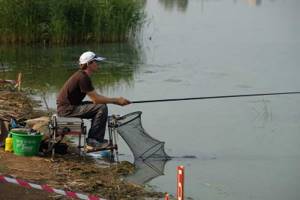
Since roaches have very delicate lips, when removing the hook, use an extractor to avoid damaging them.
Starter feeding is used if you are aiming to catch large roach. According to consistency, in warm weather we use loose complementary food, in cold weather it is denser. You need to add soil and clay to the bait. The mixture must be stirred using a bowl from a specific reservoir. It is important to keep the fish in one place; if you overfeed it, it will simply leave.
When purchasing a ready-made mixture, pay attention to the fishing season and type of fish. This information is indicated on the packaging.
Groundbait and flavors
Bait is the most important element of successful roach fishing. Despite the fact that nowadays it is easier to buy a ready-made mixture in a store, many fishermen prepare their own bait, which is in no way inferior to store-bought bait. There are several mixtures that have proven themselves in different seasons.
Recipe No. 1: Bait for spring fishing
- Base – breadcrumbs – 400 grams.
- Fillings : well-fried buckwheat – 400 grams;
- milk powder - 100 grams;
- finely chopped dung worms or bloodworms - 100 grams.
Recipe No. 2: Summer bait mixture
- Base – breadcrumbs – 400 grams;
- Fillings : Well-cooked rye grains – 100 grams.
- Porridge “Hercules” – 200 grams.
- Hemp seeds – 100 grams.
- Filamentous green algae – 50 grams.
- Sunflower cake (makukha) – 100 grams.
- Small maggot – 50 grams.
Recipe No. 3: Autumn bait
- Base – breadcrumbs – 400 grams.
- Fillings : Biscuit – 100 grams.
- Rye bran – 150 grams.
- Feed small maggot – 200 grams.
- Small bloodworms – 150 grams.
How to spot a bite
The roach has acquired the title of capricious fish. A small roach tries the bait piece by piece, biting off small pieces. At the same time, it can be very difficult to notice the movements of the float. You might think that it is the wind or the current that is pushing the float.
Let's note 3 options for possible roach bite:
- when the float rises a little;
- when the float twitches frequently;
- when the float began to move to the side.
If you notice such changes in the behavior of the float, you need to immediately hook it.
How to choose a fishing spot
Roaches can be found in rivers, canals, lakes and reservoirs, ponds, and abandoned quarries.
Smaller individuals prefer small rivers with weak currents. A good and accessible food supply and an influx of fresh water increase the likelihood of encountering a particularly large specimen.
In a school consisting of small roach, most often there are no more than two large individuals, or even one. The behavior and habits of this fish depend on the reservoir and the presence of predatory fish in it.
It is better to look for roach in holes or in those areas of the reservoir where the depth differs from usual by 50-60 centimeters.
In hot weather, you can catch a good specimen in reed thickets or in places where there is shade from overhanging trees.
Although roaches inhabit reservoirs with different bottoms, the largest individuals prefer sand or gravel; they try to ignore places with muddy bottoms.
Habitats and fishing calendar
The roach is quite unpretentious to its habitat, so it can be found both in large rivers and reservoirs, and in small flowing ponds and lakes.
It is not found in overgrown shallow, stagnant swamps, which freeze to the bottom in harsh winters. These reservoirs are dominated by another even more unpretentious representative of cyprinids - crucian carp.
Roach does not live in reservoirs with a large layer of silt or mud at the bottom; it feels best in rivers with a sandy bottom.
In a body of water it prefers to stay in the following places:
- In lakes and reservoirs, the most “roach” places are areas with rich aquatic vegetation near the shore.
- Clearings (“windows”) between thickets of aquatic plants.
- Near the mouths of rivers and streams flowing into lakes and reservoirs.
- Under the branches of trees overhanging the water.
- Large specimens prefer deep-sea, quiet backwaters.
This fish can be caught all year round, during which there are several peaks of its active biting:
- Spring (pre-spawning) - begins a month before spawning and due to sudden climate change and alternating warm and severe winters, in some years it falls during the ice fishing season, in others - open water. At this time, roach in open water enters the flooded floodplain, enters small ditches, shallow backwaters, and old fish.
- Post-spawning – begins some time after the end of spawning. Usually falls at the end of May - beginning of June. They catch it at this time in spawning areas, where the fish feed for a long time, restoring strength.
- Autumn is the shortest, “starts” at the beginning of autumn and lasts until the first frost. At this time, roaches gather in schools and move closer to the wintering pits. That’s why they catch it near the depths, on the upper edges of whirlpools, on coastal dumps.
A weak bite is observed:
- In the middle of summer - at this time, in the heat of the day, the roach hides under the shore, in the shade of trees and bushes, and goes under flooded snags. The salvation in such hot weather will be an approaching thunderstorm - the fish become active 30-50 minutes before the onset of bad weather.
- In the middle of winter - in the middle of nowhere, in contrast to the more active perch, ruffe, roach prefers to stay in deep holes all the time, from where only a few individuals go out to feed in shallow water.
What to cook from roach
This wonderful fish can be dried, salted, dried, smoked, stewed, fried and boiled. Unpretentious to store, roach has more than once saved people from hunger during hard times. There was even a monument erected to Voble in Astrakhan. Roach meat contains 19% protein, 0.4% fat and 0% carbohydrates. Roach protein is absorbed by the human body much better than beef protein. Low fat content and complete absence of carbohydrates allow this fish to be used in the diet of people suffering from diabetes or obesity. Roach contains large quantities of vitamins A, C, B1, B2, PP and E.
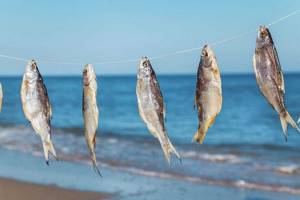
If catching roach in the spring brings results, it’s time to prepare the trophy at home or learn how to prepare it in the field.
It is also rich in various macro- and microelements: nickel, chlorine, phosphorus, calcium, magnesium, iron, potassium, sodium, molybdenum, fluorine. Just 100 g of roach meat can meet a third of an adult’s needs for vitamins PP and A, as well as completely cover the need for chromium. Roach is considered a unique fish in culinary terms, however, if certain rules are followed, even the most demanding connoisseurs of good cuisine will like it. The main disadvantage of roach is the incredible number of small bones. And the easiest way to deal with this is to marinate the fish. The acid will soften the seeds and after frying they will be invisible. Roach often tastes bitter in the ear. The culprit of this bitterness is her eyeballs, which need to be removed. When salted and dried, roach turns into the roach adored by our people. For its preparation, the best fish is one that has not yet spawned, that is, with caviar. And finally, one more interesting fact: roach caviar, it turns out, is widely used in cosmetology. It contains substances that improve the condition of skin and hair.
